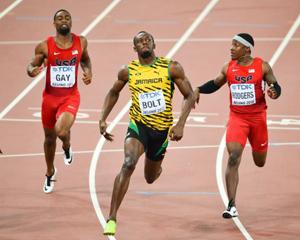Usain Bolt is the world's fastest man. But does that also mean that compared to all other competitive runners on Earth he has the best body mechanics?
Assumptions about bodily efficiency and how physical output is maximized would lead us to say, yes. The Jamaican sprinter and multiple Olympic Gold medalist has spent nearly a decade on the world stage repeatedly blazing past his competitors. And by posting the fastest recorded time in human history in 2009 – a lightning-quick 100-meter dash in 9.58 seconds – that, we might plausibly reason and would strongly suggest, as the fastest person to have ever lived his lower body operates in perfect (or near-perfect) alignment.
Some biomechanical experts pondered that thought, and did some clever investigating before concluding ...
Not so fast.
Researchers at Southern Methodist University say Bolt may actually have "an asymmetrical running gait," citing findings announced today. They haven't concluded their scientific investigation, but the school stated that based on analysis of super-slowed-down video of some of his televised races, this super-high-speed sprinter strikes the ground with more force with his right leg than he does with his left.
For the fastest sprinter of all time, that difference alone is stunning in that "experts generally assume asymmetry impairs performance and slows runners down," according to a SMU news release. But if that's not enough, these preliminary findings also raise at least two tantalizing questions:
- Is this apparent asymmetry a hindrance to Bolt running even faster?
- Or could his unique asymmetry be part of the reason he's the world's fastest man?
"Our observations raise the immediate scientific question of whether a lack of symmetry represents a personal mechanical optimization that makes Bolt the fastest sprinter ever or exists for reasons yet to be identified," said Andrew Udofa, a biomechanics researcher in the SMU Locomotor Performance Laboratory and a member of the research team.
The team concluded Bolt ran in an asymmetrical fashion by using NBC Sports video of him and other world-class runners competing to help "assess his pattern of ground-force application – literally how hard and fast each foot hits the ground." Here's video from the laboratory, with a synchronized graph displaying data, showing the force exerted during each step; credit: SMU Locomotor Lab.) Bolt's imbalance, or asymmetry, statistically emerges when his right foot pounds the track with greater force than his left.
"Both the timing and magnitude of force application," added Udofa, "differed between legs in the steps we have analyzed so far."
To produce their measurements, the research team developed a model that "integrates classic physics and human anatomy to link the motion of individual runners to their patterns of force on the ground," and, according to the release, the model "provides accurate predictions of the ground force vs. time patterns throughout each instant of the contact period, regardless of limb mechanics, foot-strike type or running speed."
In a word: fascinating.
We look forward to learning more about Bolt's mechanics, and additional findings the team presents in the future.




